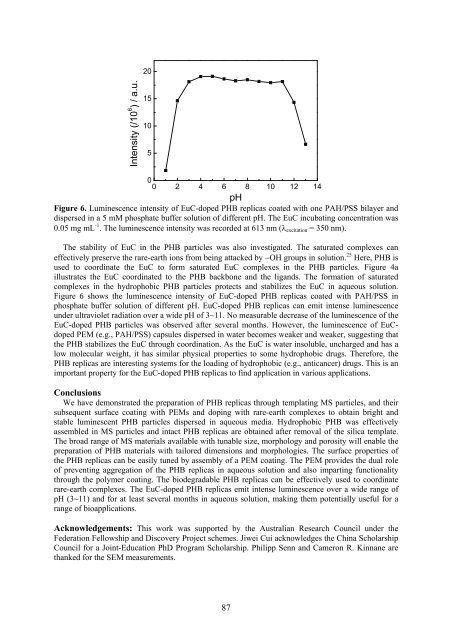Workshop proceeding - final.pdf - Faculty of Information and ...
Workshop proceeding - final.pdf - Faculty of Information and ...
Workshop proceeding - final.pdf - Faculty of Information and ...
You also want an ePaper? Increase the reach of your titles
YUMPU automatically turns print PDFs into web optimized ePapers that Google loves.
20<br />
Intensity (/10 6 ) / a.u.<br />
15<br />
10<br />
5<br />
0<br />
0 2 4 6 8 10 12 14<br />
pH<br />
Figure 6. Luminescence intensity <strong>of</strong> EuC-doped PHB replicas coated with one PAH/PSS bilayer <strong>and</strong><br />
dispersed in a 5 mM phosphate buffer solution <strong>of</strong> different pH. The EuC incubating concentration was<br />
0.05 mg mL -1 . The luminescence intensity was recorded at 613 nm (λ excitation = 350 nm).<br />
The stability <strong>of</strong> EuC in the PHB particles was also investigated. The saturated complexes can<br />
effectively preserve the rare-earth ions from being attacked by −OH groups in solution. 25 Here, PHB is<br />
used to coordinate the EuC to form saturated EuC complexes in the PHB particles. Figure 4a<br />
illustrates the EuC coordinated to the PHB backbone <strong>and</strong> the lig<strong>and</strong>s. The formation <strong>of</strong> saturated<br />
complexes in the hydrophobic PHB particles protects <strong>and</strong> stabilizes the EuC in aqueous solution.<br />
Figure 6 shows the luminescence intensity <strong>of</strong> EuC-doped PHB replicas coated with PAH/PSS in<br />
phosphate buffer solution <strong>of</strong> different pH. EuC-doped PHB replicas can emit intense luminescence<br />
under ultraviolet radiation over a wide pH <strong>of</strong> 3~11. No measurable decrease <strong>of</strong> the luminescence <strong>of</strong> the<br />
EuC-doped PHB particles was observed after several months. However, the luminescence <strong>of</strong> EuCdoped<br />
PEM (e.g., PAH/PSS) capsules dispersed in water becomes weaker <strong>and</strong> weaker, suggesting that<br />
the PHB stabilizes the EuC through coordination. As the EuC is water insoluble, uncharged <strong>and</strong> has a<br />
low molecular weight, it has similar physical properties to some hydrophobic drugs. Therefore, the<br />
PHB replicas are interesting systems for the loading <strong>of</strong> hydrophobic (e.g., anticancer) drugs. This is an<br />
important property for the EuC-doped PHB replicas to find application in various applications.<br />
Conclusions<br />
We have demonstrated the preparation <strong>of</strong> PHB replicas through templating MS particles, <strong>and</strong> their<br />
subsequent surface coating with PEMs <strong>and</strong> doping with rare-earth complexes to obtain bright <strong>and</strong><br />
stable luminescent PHB particles dispersed in aqueous media. Hydrophobic PHB was effectively<br />
assembled in MS particles <strong>and</strong> intact PHB replicas are obtained after removal <strong>of</strong> the silica template.<br />
The broad range <strong>of</strong> MS materials available with tunable size, morphology <strong>and</strong> porosity will enable the<br />
preparation <strong>of</strong> PHB materials with tailored dimensions <strong>and</strong> morphologies. The surface properties <strong>of</strong><br />
the PHB replicas can be easily tuned by assembly <strong>of</strong> a PEM coating. The PEM provides the dual role<br />
<strong>of</strong> preventing aggregation <strong>of</strong> the PHB replicas in aqueous solution <strong>and</strong> also imparting functionality<br />
through the polymer coating. The biodegradable PHB replicas can be effectively used to coordinate<br />
rare-earth complexes. The EuC-doped PHB replicas emit intense luminescence over a wide range <strong>of</strong><br />
pH (3~11) <strong>and</strong> for at least several months in aqueous solution, making them potentially useful for a<br />
range <strong>of</strong> bioapplications.<br />
Acknowledgements: This work was supported by the Australian Research Council under the<br />
Federation Fellowship <strong>and</strong> Discovery Project schemes. Jiwei Cui acknowledges the China Scholarship<br />
Council for a Joint-Education PhD Program Scholarship. Philipp Senn <strong>and</strong> Cameron R. Kinnane are<br />
thanked for the SEM measurements.<br />
87
















